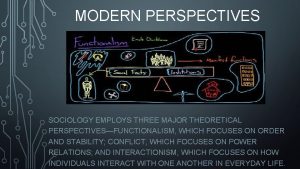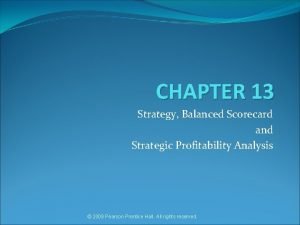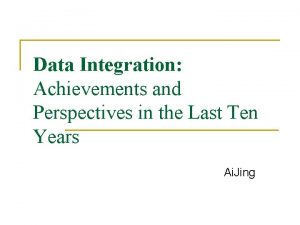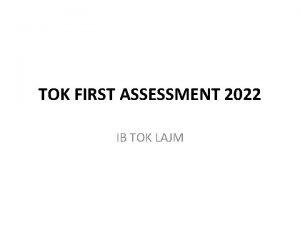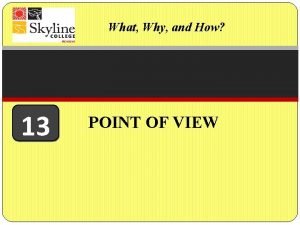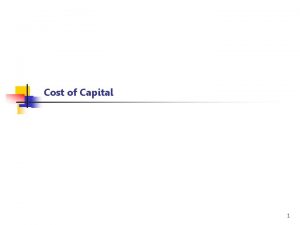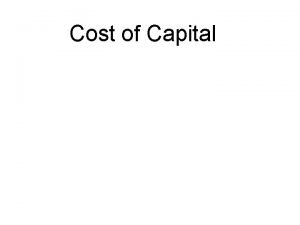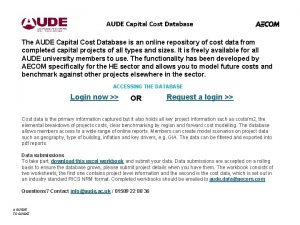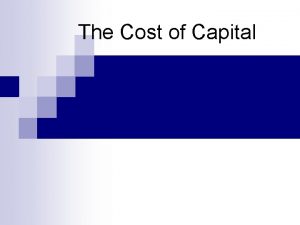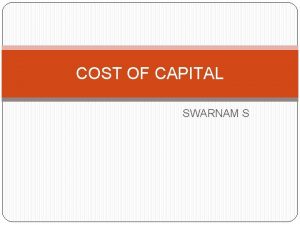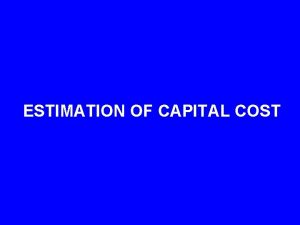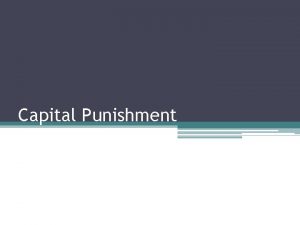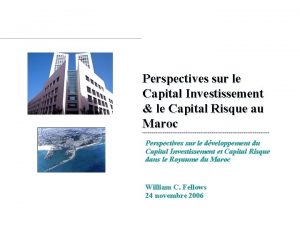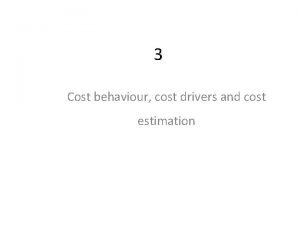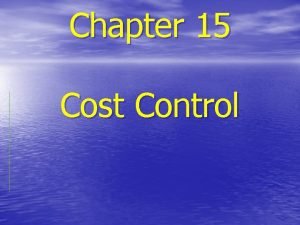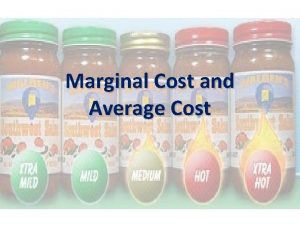Cost of Capital 1 Cost of Capital Perspectives

















- Slides: 17

Cost of Capital 1

Cost of Capital Perspectives 2

WACC Formula (Wd) x (kd) + (Wp) x (kp) + (Wc) x (kc) Wd – Weight of long-term debt Wp – Weight of preferred shares Wc – Weight of common shares kd – Cost of long-term debt kp – Cost of preferred shares kc – Cost of common shares 3

WACC q WACC is the weighted average cost of permanent debt and equity financing only q Special applications include: q WMCC for projects in new industries q Divisional costs of capital q Private companies q Cost of capital components can be estimated using data from a pure play q Pure play is one or a group of comparable companies whose k d, kp, and kc approximate the risk level of the proposed project or division q Pure plays are difficult to find and their capital structures may not be similar, but their betas can be adjusted to reflect varying borrowing levels q Cost of capital should be adjusted for project risk Project Risk Category Project Types Adjustment WACC High New product expansions +2% 10% Moderate Cost savings projects Existing product expansions -0% 8% Low Equipment replacement -2% 6% Mandatory Environmental or safety equipment Not applicable 4

WACC - Weights q Weighting methods include: Book value Market value Target capital structure q Book values are easy to obtain but they are outdated q Market values are current but they fluctuate considerably and are not available for private companies q Stocks and bonds are issued in large amounts due to economies of scale so debt and equity weights can vary in the short term q Target capital structure is preferred because it is forward looking, stable, and does not require a share price q Not all companies know their target capital structure so market value is the next best choice, followed by book value if market values are not available 5

Cost of Common Shares CAPM kc = kf + Ba (km – kf) Implied kc kc = (D 1 / P 0) + g Treasury spread kc = kf + Spread. T Adjusting beta for financial leverage BL = BU (1 + (1 – t)(D/E)) q Cost of other equity securities such as stock options, warrants, rights, and conversion features should also be included in WACC but they normally make up a small part of total equity 6

Cost of Preferred Shares Implied kp kp = D 1 / P 0 q CAPM is not used to calculate kp because preferred shares have fixed payments like bonds so their betas are close to zero q If the price of a preferred share cannot be determined, k p may be estimated using the preferred shares of other companies with the same credit rating q A synthetic credit rating can be estimated by a credit rating agency if the company has not undergone a formal credit evaluation q Credit rating agencies have separate rating scales for long-term bonds, short-term debt securities, and preferred shares 7

Cost of Long-term Debt Implied kd P 0 = (I) (1 – (1 + kd)-n) / kd) + Principal / (1 + kd)n kd after tax = (kd) (1 – t) Treasury Spread kd = k. T + Spread. T kd after tax = (kd) (1 -t) q Cost of debt can be estimated using bonds with similar credit ratings, terms to maturity, collateral, subordination, and guarantees if a bond price is not available q A synthetic credit rating can be estimated by a credit rating agency if the company has not undergone a formal credit evaluation q Commercial loans and leases do not trade publicly so recently negotiated lending agreements with the same maturity and similar features are used to approximate the cost of debt q Companies will likely have more than one source of debt financing, so they should determine a weighted-average cost of debt using the current market rate and market value of each issue 8

Incorporating Issuance Costs Increase the Cost of Capital Retained earnings New common shares New preferred shares New long-term debt after tax kc = (D 1 / P 0) + gd kc = D 1 / (P 0 – f) + gd kp = D 1 / (P 0 – f) (kd) (1 – t) / (1 – f) Include as a Negative Initial Cash Flow q After-tax issuance costs are included as a negative initial cash flow in the capital budgeting process Preferred Approach q First method is least preferred as this spreads the issuance costs out over the life of the project instead of recognizing them all at the beginning when incurred 9

CAPM – Risk-free Rate and MRP 10

CAPM – Raw Beta q Slope of the regression line between the (excess) returns of the market portfolio and the (excess) returns of the company q Excess returns deduct the 30 -day treasury rate to allow for inflation q Market value-weighted versus equal-weighted index q Use total return including dividends, capital gains, and stock splits q Issues when calculating a historical raw beta q q Measurement period Return interval – intra-day, daily, weekly, monthly, quarterly, or yearly Non-trading bias Poor regression results – R squared, t-stats, coefficient sign, confidence interval q Financial information providers supply beta estimates 11

CAPM – Adjusted Betas 12

CAPM – Other Betas Industry and Peer Group Betas q Market value-weighted versus equal-weighted Accounting Betas q Substitute accounting earnings for share price q Regression based on key performance indicators Unlevered and Levered Betas q Business risk (sales risk, operating risk) versus financial risk q Financial leverage BU = BU (1 + (1 – t)(D/E)) BU = BU + (1 – t)(D/E)(BU – BD) q Operating leverage BU = BU (1 + (FC/VC)) 13

CAPM – Size Premiums q CAPM considers market risk only, but firm size is also an important factor Company Size Beta Realized Return Large-cap Mid-cap Low-cap Micro-cap 0. 98 1. 12 1. 23 1. 36 11. 80% 13. 70% 15. 16% 18. 03% Estimated Return Using CAPM 11. 60% 12. 56% 13. 28% 14. 14% Size Premium 0. 40% 1. 14% 1. 88% 3. 89% q Modified CAPM kc = kf + Ba (km – kf) + Size Premium q Financial information providers supply size premiums for mid-cap, low-cap, and micro-cap firms q Size premiums occur due to: q q q Lack of investment diversification Fewer financial resources and lower barriers to entry Inability to attract the best personnel and spend enough on R&D and advertising Lower share liquidity and higher transaction costs Poorer financial oversight as fewer analysts follow the company 14

Cost of Long-term Debt q Companies have more than one source of debt financing, so they should determine a weighted-average cost of debt using the current market rate and market value of each issue q Commercial loans and leases do not trade publicly so recently negotiated agreements with the same maturity and similar features should be used q Cost of debt is difficult to determine when bonds have floating interest rates; are convertible, redeemable, callable; or have purchase fund requirements q Simpler way to calculate the cost of debt is to establish a corporate yield curve for other firms with the same credit rating and then prorating these interest rates using the book value of a company’s debt at each maturity q A synthetic credit rating can be estimated by a credit rating agency if a firm has not undergone a formal credit evaluation q Other long-term obligations including future income taxes, contingent liabilities and pension liabilities are excluded as they were not negotiated to finance a project and are not interest bearing 15

Alternate Cost of Common Equity Models Market specific risk Company specific risk 16

Duff & Phelps References q q q Stocks, Bonds, Bills, and Inflation (SBBI) Yearbook Valuation Handbook – U. S. Guide to Cost of Capital Valuation Handbook – U. S. Industry Cost of Capital International Valuation Handbook – Guide to Cost of Capital International Valuation Handbook – Industry Cost of Capital Navigator Industry Data CAPM Estimates q U. S. normalized risk-free rate = 3. 0% q U. S. MRP = 5. 0% 17
 Multinational cost of capital and capital structure
Multinational cost of capital and capital structure Multinational cost of capital and capital structure
Multinational cost of capital and capital structure Psychology perspectives
Psychology perspectives Interactionist perspectives
Interactionist perspectives Four major perspectives of psychology
Four major perspectives of psychology Major perspective in sociology
Major perspective in sociology Tok religious knowledge
Tok religious knowledge Balanced scorecard perspectives
Balanced scorecard perspectives Data integration problems approaches and perspectives
Data integration problems approaches and perspectives Perspectives on ideology
Perspectives on ideology 6 personal perspectives kw
6 personal perspectives kw Major perspectives in psychology
Major perspectives in psychology Optional themes tok
Optional themes tok Environmental perspectives
Environmental perspectives Tabular editor scripts
Tabular editor scripts Global perspective research questions
Global perspective research questions Author point of view
Author point of view Major perspectives in psychology
Major perspectives in psychology





